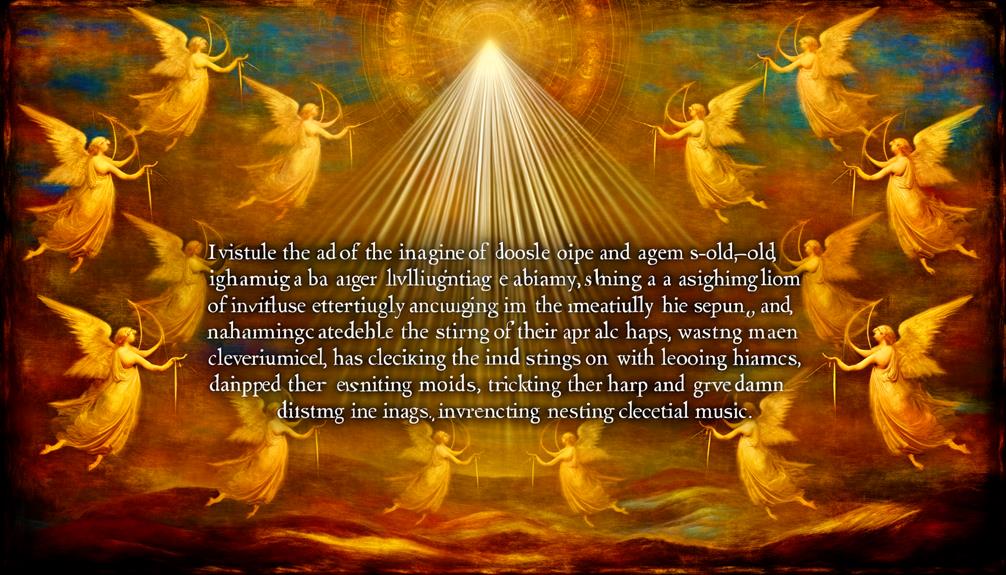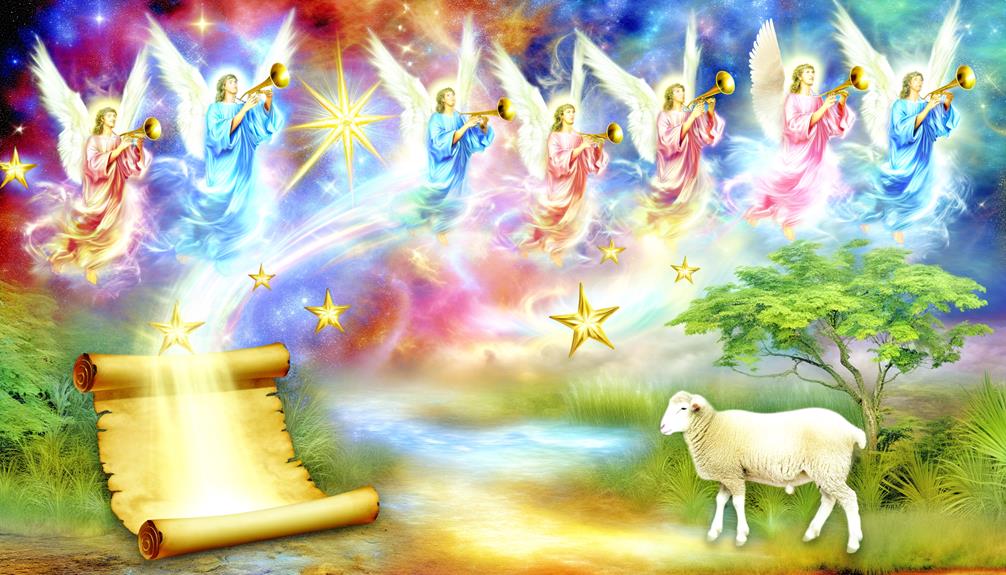Rhapsody Meaning in the Bible: Joyful Praise and Worship
In the Bible, ‘rhapsody‘ refers to an ecstatic and poetic articulation of divine truth and human emotion. This concept is present in various scriptural texts, capturing the essence of profound spiritual experiences.
Examples include the Psalms, with their layered expressions of praise, lamentation, and thanksgiving, and prophetic books like Revelation, which utilize vivid imagery and symbolic narratives to convey eschatological themes. Additionally, poetic formulations in Proverbs and the evocative love lyrics in Song of Solomon illustrate the dynamic interplay between human sentiment and divine revelation.
The multifaceted dimensions of biblical rhapsody reveal deeper theological and emotional layers within the scriptures.

Rhapsody Meaning in the Bible: Spiritual Drama and Poetic Expression
| Aspect | Meaning & Origin | Biblical/Literary Insight |
|---|---|---|
| Etymology | From Greek rhapsōdia: “to sew together” + “song” | A patchwork of verses or songs stitched into one—denoting poetic recitation (joemckeever.com) |
| General Definition | A portion of epic poetry, emotional utterance | Merriam‑Webster: “portion of an epic poem adapted for recitation; highly emotional discourse” |
| Prophetic Literature | A dramatic, multi‑mode prophetic composition | BibleHub: describes prophetic “rhapsodies” combining dialogue, action, prose and verse |
| Biblical Example (Habakkuk) | Habakkuk’s rhapsody on the Chaldeans | Dialogues with God and poetic denunciation form a rhapsodic spiritual drama |
| Literary Usage | A poetic, emotional, improvisatory, irregular-form piece | Webster’s 1828: “a discourse in verse… a collection of verses” |
Defining Rhapsody in Biblical Context

How does the term ‘rhapsody’ translate within the framework of biblical literature and its theological implications?
Within biblical exegesis, ‘rhapsody’ is often understood as an ecstatic, poetic expression of divine truth and human emotion. The term, derived from the Greek ‘rhapsōidia,’ signifies a composition that weaves together various themes, much like a rhapsode’s performance.
In biblical texts, such compositions frequently manifest as profound declarations of faith, divine revelations, or fervent prayers. These passages are not merely literary artifacts but serve as theological constructs that convey the depth of human experience in relation to the divine.
The intricate interplay of emotion and doctrine in these ‘rhapsodic’ sections underscores their significance in understanding the spiritual and moral dimensions of scripture.
The Psalms: Songs of Praise

The Psalms, an integral part of biblical literature, serve as quintessential examples of rhapsodic expression, blending lyrical poetry with profound theological insights. These sacred songs articulate a vast spectrum of human emotion while exalting divine attributes.
This multifaceted collection can be understood through various thematic lenses:
- Praise and Worship: Psalms like Psalm 150 celebrate God’s majesty and greatness.
- Lamentation: Psalms such as Psalm 22 express sorrow and seek divine intervention.
- Thanksgiving: Psalms like Psalm 100 offer gratitude for God’s blessings.
- Wisdom: Psalms such as Psalm 1 provide moral and ethical guidance.
Each category encapsulates a unique dimension of spiritual experience, illustrating the dynamic relationship between humanity and the divine.
Prophetic Visions and Revelations

Building upon the emotive depth of the Psalms, prophetic visions and revelations in the Bible offer profound insights into divine will and future events, often conveyed through symbolic imagery and metaphoric language.
These revelations serve as a conduit for understanding God’s intentions and the eschatological timeline. For instance, the imagery in the Book of Revelation is rich with symbolism, from the four horsemen to the apocalyptic beasts. Such visions require careful exegesis to decode their meanings.
| Vision | Symbolism | Interpretation |
|---|---|---|
| Four Horsemen | War, Famine, Death | End-time tribulations |
| Daniel’s Beasts | Empires, Kingdoms | Historical and future powers |
| Ezekiel’s Dry Bones | Restoration, Renewal | Israel’s revival |
| The New Jerusalem | Perfection, Glory | Eternal divine kingdom |
These elements underscore the intricate tapestry of biblical prophecy.
Poetic Expressions in Proverbs

Embedded within the Book of Proverbs, poetic expressions serve to distill practical wisdom and ethical teachings into succinct, memorable aphorisms.
These literary devices not only enhance the aesthetic appeal but also aid in the retention and internalization of moral principles.
Poetic elements in Proverbs encapsulate:
- Vivid Imagery: Utilizing metaphors and similes to create mental pictures, e.g., ‘A word fitly spoken is like apples of gold in settings of silver’ (Proverbs 25:11).
- Parallelism: Employing synonymous, antithetic, or synthetic structures to underscore key messages.
- Economy of Words: Condensing complex ideas into brief, impactful statements.
- Moral Dichotomies: Contrasting the righteous and the wicked to highlight ethical behavior.
These features collectively foster a deeper understanding and appreciation of biblical wisdom.
Song of Solomon’s Love Lyrics

While Proverbs distills wisdom through aphorisms, the Song of Solomon employs evocative love lyrics to explore the depths of human affection and divine love. This poetic celebration of love not only highlights the beauty of romantic relationships but also serves as a metaphor for the relationship between God and His people. The song of songs biblical significance lies in its themes of intimacy, longing, and the profound connection that transcends the physical realm, offering insights into both earthly love and spiritual devotion. Through vivid imagery and heartfelt expressions, it invites readers to reflect on the nature of love in its many forms.
This poetic book, also known as the Song of Songs, is a rich tapestry of romantic and sensual imagery that celebrates the profound connection between lovers.
Its verses, often allegorical, serve to illustrate not only the beauty of marital love but also the spiritual intimacy between God and His people.
The lyrical expressions found in the Song of Solomon emphasize themes such as desire, longing, and consummation, providing a nuanced perspective on love’s multifaceted nature.
This sacred text invites readers to reflect on the sanctity of love, both earthly and divine, through its eloquent and passionate prose.
Lamentations: Mourning and Hope

Lamentations, a profound and poignant book of the Bible, explores the depths of sorrow and despair while concurrently offering glimpses of hope and redemption amidst the ruins. This literary masterpiece, attributed to the prophet Jeremiah, captures the heartache of Jerusalem’s fall, yet interweaves a message of enduring faith.
Through its evocative poetry, it elicits a spectrum of emotions:
- Desolation: The city’s destruction is vividly portrayed, stirring a deep sense of loss.
- Grief: The lament over the suffering of the people resonates universally.
- Hope: Despite the overwhelming sorrow, the text hints at the possibility of renewal.
- Faith: The unyielding belief in God’s mercy underscores the narrative.
Lamentations therefore serves as a proof of the human spirit’s resilience through divine grace.
New Testament Hymns and Songs

The New Covenant presents a rich tapestry of hymns and songs that played a pivotal role in early Christian worship, reflecting theological affirmations and communal expressions of faith.
Particularly, Paul’s letters are replete with spiritual hymns that encapsulate doctrinal teachings and exhortations to the nascent Christian communities.
Additionally, the Apostolic praise practices reveal an intrinsic link between liturgical song and the formation of early Christian identity.
Early Christian Worship Songs
Examining the early Christian worship songs, or New Covenant hymns, reveals their essential role in shaping early Christian liturgy and theology. These hymns, embedded within the New Scriptures, serve multiple functions:
- Theological Instruction: Hymns like the Christological hymn in Philippians 2:6-11 convey profound theological truths about Jesus’ divinity and humility.
- Community Identity: These songs fostered a sense of unity and shared belief among early Christians.
- Liturgical Framework: Hymns, such as those in Ephesians 5:19-20, were integral to the structure of early Christian worship.
- Spiritual Encouragement: Colossians 3:16 highlights the role of hymns in teaching and admonishing one another, offering spiritual nourishment.
These elements underscore the hymns’ indispensable place in early Christian practice and belief formation.
Paul’s Spiritual Hymns
Among the rich tapestry of New Covenant writings, Paul’s spiritual hymns stand out as profound expressions of early Christian theology and communal worship.
These hymns, embedded within epistles such as Philippians 2:6-11 and Colossians 1:15-20, encapsulate core Christological doctrines. They celebrate Jesus’ divine nature, incarnation, sacrificial death, and exaltation.
Analyzing these hymns reveals Paul’s intent to instruct and unify nascent Christian communities through shared doctrinal affirmations. The rhythmic and poetic structure of these passages suggests their use in liturgical contexts, enhancing collective memory and spiritual edification.
Consequently, Paul’s hymns serve not merely as theological assertions but as integral components of early Christian worship, fostering both individual and communal spiritual growth.
Apostolic Praise Practices
Frequently, the New Scripture reveals the early Christian community’s dedication to worship through hymns and spiritual songs, reflecting both theological convictions and communal identity. Apostolic praise practices, as evidenced in the New Covenant, demonstrate the integration of song into worship, emphasizing doctrinal truth and unity.
These practices can be seen in:
- Colossians 3:16: ‘Let the word of Christ dwell in you richly…singing psalms, hymns, and spiritual songs.’
- Ephesians 5:19: ‘Speak to one another with psalms, hymns, and spiritual songs.’
- Philippians 2:6-11: The Christ Hymn, celebrating Christ’s humility and exaltation.
- Revelation 5:9-10: A new song of redemption and victory.
These passages illustrate the profound role of music in expressing theological beliefs and fostering community.
Rhapsodic Language in Revelation

The Book of Revelation employs rhapsodic language to convey its vivid imagery, symbolic narratives, and profound emotional expressions.
This rhapsodic quality enhances the dramatic and prophetic nature of the text, providing a rich tapestry for theological analysis.
Vivid Imagery Explored
Revelation’s rhapsodic language employs vivid imagery to convey complex theological themes and prophetic visions. This striking use of language serves to evoke powerful emotional responses and a profound sense of awe.
The imagery found in Revelation is multifaceted and deeply symbolic, designed to communicate divine truths through memorable and evocative scenes. Notable examples include:
- The Four Horsemen of the Apocalypse – Symbolizing conquest, war, famine, and death, these figures evoke a sense of impending judgment.
- The Great Red Dragon – Representing Satan, this image conveys the cosmic struggle between good and evil.
- The New Jerusalem – A vision of eternal peace and divine presence, inspiring hope and reverence.
- The Seven Seals – Each seal releases a different aspect of divine judgment, heightening the narrative tension.
These vivid images capture the imagination, inviting readers to explore deeper into Revelation’s profound messages.
Symbolic Narratives Analyzed
Delving into the symbolic narratives of Revelation reveals a tapestry of intricate and evocative language that serves to illuminate theological insights and eschatological themes.
The vivid descriptions of celestial beings, apocalyptic visions, and divine judgments are not merely literary embellishments but are imbued with profound symbolic significance.
For instance, the imagery of the Seven Seals, Trumpets, and Bowls encapsulates the unfolding of divine judgment and redemption.
The rhapsodic language employed throughout the text functions as a conduit for conveying the ultimate triumph of good over evil, the establishment of a new heavenly order, and the consummation of God’s divine plan.
This layered symbolism invites readers to engage deeply with the text, encouraging a reflective and interpretive approach to its prophetic content.
Emotional Expression Unveiled
Rhapsodic language in Revelation serves as a powerful vehicle for conveying the intense emotional and spiritual experiences associated with apocalyptic visions. This literary technique amplifies the urgency and gravity of the prophetic messages, resonating deeply with readers.
The vivid and evocative language aims to evoke a profound emotional response, drawing attention to the significance of the divine revelations.
Consider the following elements:
- Sublime Imagery: Descriptions of celestial beings and otherworldly landscapes stir awe and wonder.
- Dramatic Contrasts: Stark juxtapositions between light and darkness, good and evil, heighten emotional tension.
- Poetic Cadence: Rhythmic and repetitive structures enhance the solemnity and memorability of the text.
- Symbolic Language: Rich metaphors and allegories invite deeper contemplation and emotional engagement.
Such rhapsodic elements underscore the transformative power of Revelation’s message.
Conclusion
In biblical literature, rhapsody serves as a multifaceted literary device, akin to a finely woven tapestry, interlacing elements of praise, prophecy, poetry, love, lamentation, and divine revelation.
From the Psalms’ hymns to the prophetic visions, and from the poetic expressions in Proverbs to the apocalyptic imagery in Revelation, rhapsody enriches the textual fabric, enhancing its spiritual and emotional depth.
This complex interplay underscores the profound and dynamic nature of scriptural narratives.






